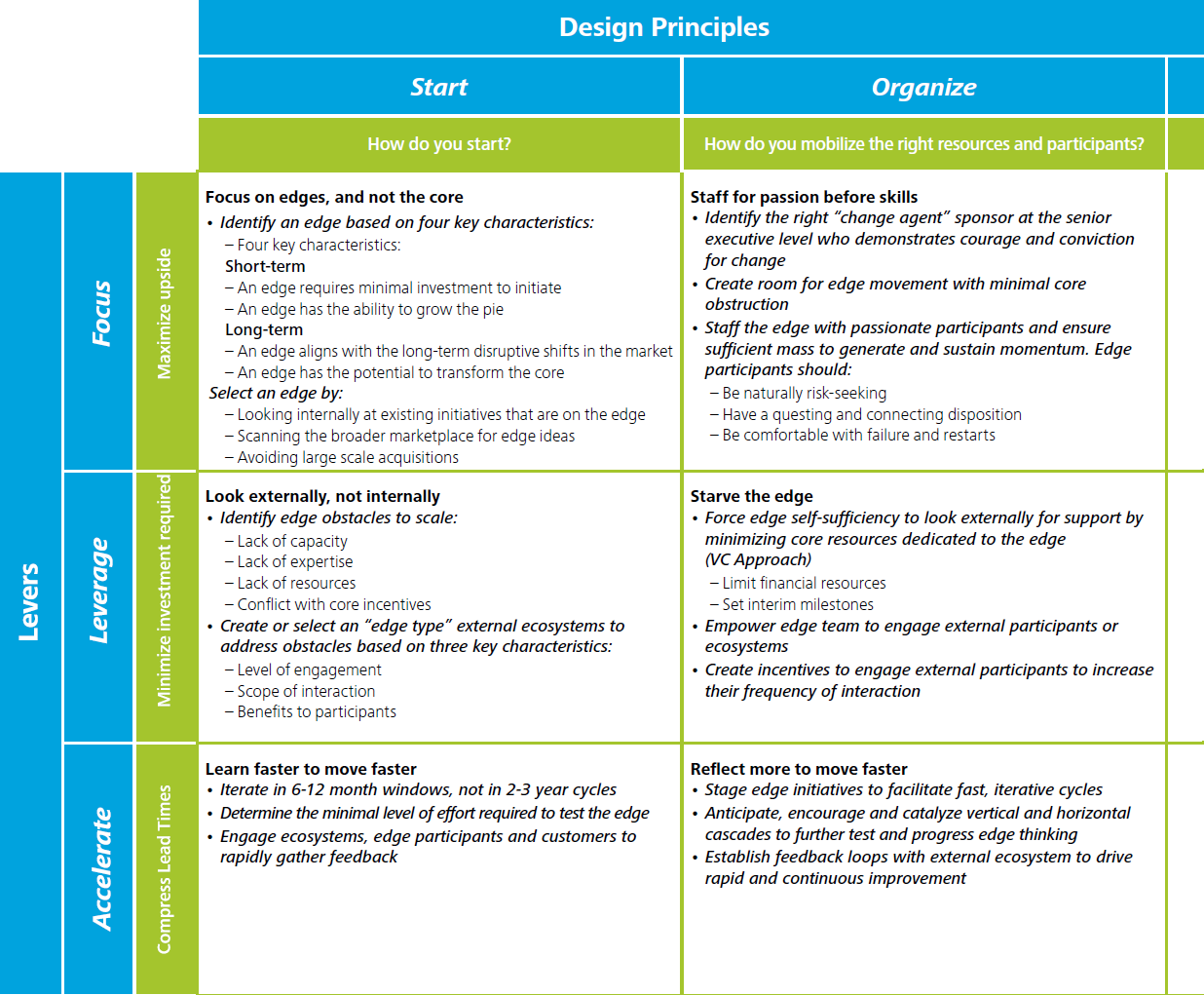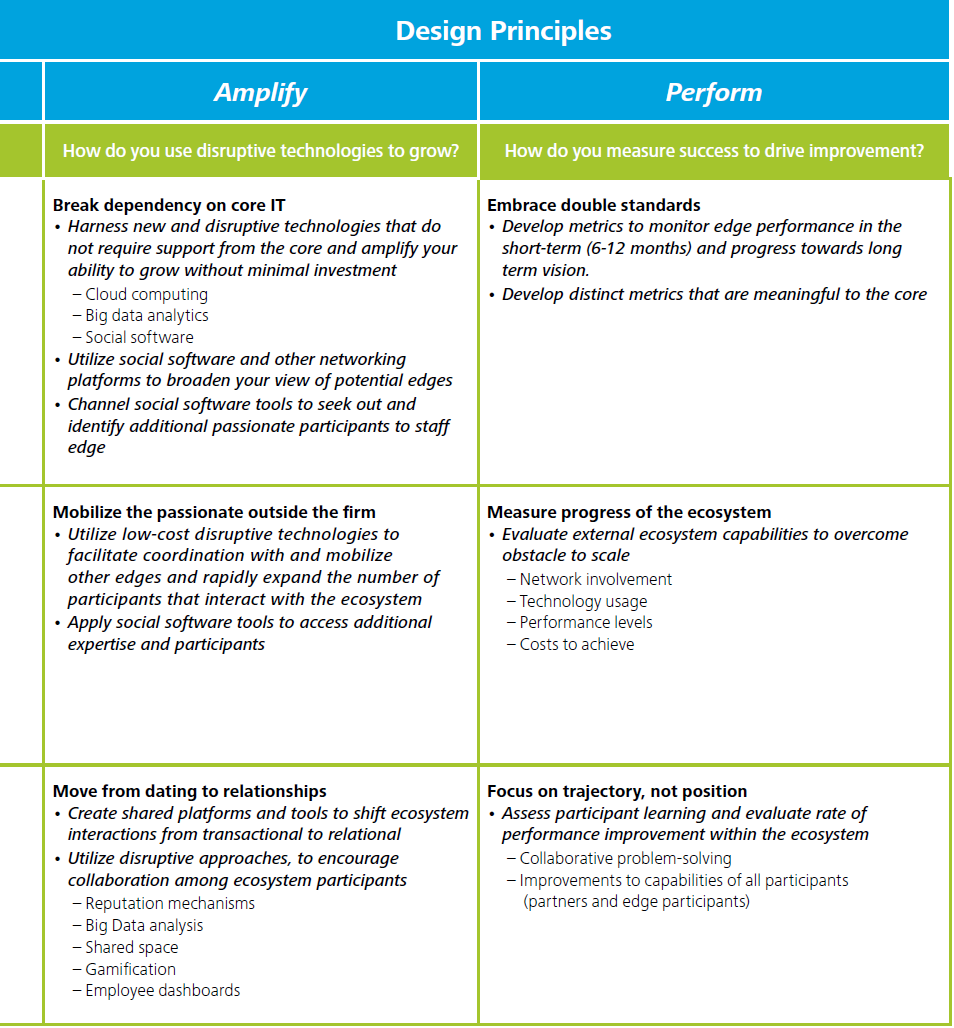Dual approaches are evermore finding their way into corporate strategy, development and innovation. There are several manifestations at play, such as
- Organizational Ambidexterity: Drawing on Tushman/O’Reilly, an ambidextrous approach is deployed if a venture is of high strategic relevance and its synergies with core business are high, therefore suggesting a strong leverage of core assets and capbilities as well as an ultimate integration into core business in the course of scaling.
- Dual Transformation: Drawing on Scott D. Anthony et al. from Innosight, Dual Transformation delineates the process of ‘Repositioning the Core’ and ‘Creating the New’ concurrently but separately. It makes use of selectively exchanging unique capabilities that provide the new venture with an “unfair advantage”.
- Innovation Colony: Drawing on Owens/Fernandez, an Innovation Colony is a dedicated external space aiming at incubating new corporate ventures that have previously been spun out from the corporate umbrella. Once those ventures become validated, they are spun in again in order to scale them by leveraging core resources and capabilities.
Another variant has been proposed by John Hagel et al. from Deloitte: Rather than attempting to transform a company’s core – and thereby exciting the immune system’s response to crush the innovation or transformation effort – they suggest to ‘scale edges’ separately through tapping into external resources and networks initially. Over time, as first results and tangible impact become obvious, resources are naturally pulled from the core into the edge (vs. the edge being pushed into the core).
In this context, edges are defined as growth or change initiatives that meet the following criteria:
- They exhibit modest resource requirements and minimized dependency on the core in the early stages
- They align with the long-term disruptive shifts in the market
- In the short-term, edges are platforms for high growth that have the potential to grow the pie and scale
- In the long-term, edges have the potential to transform the core and be a catalyst for change
According to the report, the rationale behind this approach is threefold:
Changing the core has an uncertain return
A company’s core business is what they know best, and making significant changes to this core can be a very risky endeavor for most firms. If the project fails, then the company’s core operations may be irrevocably altered. Even if a change agent within the firm strongly believes in the returns, other leaders unable to see past the uncertainty may push back, creating a cycle of resistance that can weaken or kill an initiative.
Changing the core requires a great deal of resources
An overhaul of an organization’s core operations requires a large upfront investment and a willingness to accept substantial losses while the company reorganizes and refocuses. Even if an organization has sufficient resources for the project, such a large reallocation will threaten the status quo and usually raise ‘institutional antibodies’ to change within the core stakeholders. As the performance pressures continue to mount on firms and executives, we believe that summoning the resources to enact change within the core will only become more difficult.
Changing the core requires a great deal of time
The high risk and uncertain reward of significant change initiatives often leads to substantial resistance. The leadership teams’ natural inclination against change can take two forms: active or passive-aggressive resistance. Passive-aggressive resistance can be equally distracting and time-intensive to combat and can create the illusion of progress, where stakeholders “agree” during meetings but fail to take action after, or worse yet, work against the effort in the background.

With that said, the authors draw the ensuing conclusion:
Deploying an edge model will not be an easy undertaking for todays’ firms. An edge-core mentality requires core leadership to detach themselves from promising initiatives and edge leadership to be scrappy and resourceful – despite being attached to a deep-pocketed organization. To successfully choose an edge, firms must first develop a deep understanding of the forces at work in the economy and how these will play out in their own industry, which can be a challenge for organizations used to benchmarking solely against their own peers. We believe, however, that the framework described (and elaborated upon in the subsequent key design principles section) can help firms start to build useful habits, both habits of thoughts and habits of action, which can move them down their own pragmatic pathway to change.


Takeaway
Dual innovation and transformation approaches prove to be indispensable for companies to stay future-proof. The adequate manifestation – i.e. the way a dual approach is implemented and structured – however, highly depends on the context at hand. Relevant external and internal criteria involve
- characteristics and timeline of the venture
- degree of strategic relatedness between venture and core business
- conflict potential
- disruptiveness of the venture
- degree of synergies
- external industry dynamics
- company’s innovation and transformation maturity
What all approaches share in common: A dual set of ‘units of investigation’, i.e. core business and new venture (or initiative).
Where they distinguish from each other: The degree of connection between those disparate units and its evolution over time. This entails in particular different paths to scaling up the venture into substantial impact, e.g. business or organizational transformation/change.
Most likely, those variants build a complementary set, contributing to a comprehensive dual approach to innovation and transformation.
More on this to come soon…








No comments yet.